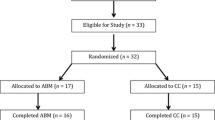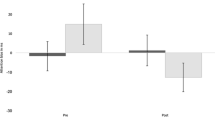Abstract
Attention bias modification (ABM) was introduced over a decade ago as a computerized method of manipulating attentional bias and has been followed by intense interest in applying ABM for clinical purposes. While meta-analyses support ABM as a method of modifying attentional biases and reducing anxiety symptoms, there have been notable discrepancies in findings published within the last several years. In this review, we comment on recent research that may help explain some of the inconsistencies across ABM studies. More relevant to the future of ABM research, we highlight areas in which continuing research is needed. We suggest that ABM appears to be a promising treatment for anxiety disorders, but relative to other interventions, ABM is in its infancy. Thus, research is needed in order to improve ABM as a clinical treatment and advance the psychological science of ABM.
Similar content being viewed by others
References
Papers of particular interest, published recently, have been highlighted as: • Of importance •• Of major importance
Bar-Haim Y, Lamy D, Pergamin L, Bakermans-Kranenburg MJ, van IJzendoorn MH. Threat-related attentional bias in anxious and nonanxious individuals: a meta-analytic study. Psychol Bull. 2007;133(1):1–24. doi:10.1037/0033-2909.133.1.1.
Heinrichs N, Hofmann SG. Information processing in social phobia: a critical review. Clin Psychol Rev. 2001;21(5):751–70. doi:10.1016/S0272-7358(00)00067-2.
Hofmann SG. Cognitive factors that maintain social anxiety disorder: a comprehensive model and its treatment implications. Cogn Behav Ther. 2007;36(4):193–209. doi:10.1080/16506070701421313.
Kuckertz JM, Amir N. Cognitive biases in social anxiety disorder. In: Hofman SG, DiBartolo PM, eds. Social anxiety: clinical, developmental, and social perspectives. 3rd ed. San Diego: Elsevier; 2014.
Williams J, Watts F, MacLeod C, Mathews A. Cognitive psychology and emotional disorders. 2nd ed. Chichester: Wiley; 1997.
Mathews A, MacLeod C. Induced processing biases have causal effects on anxiety. Cogn Emot. 2002;16:310–5. doi:10.1080/02699930143000518.
Mogoaşe C, David D, Koster EHW. Clinical efficacy of attentional bias modification procedures: an updated meta-analysis. J Clin Psychol. 2014. doi:10.1002/jclp.22081. This updated meta-analysis examined effect sizes for (1) change in attention bias and (2) change in symptoms separately for different clinical conditions (e.g., anxiety, depression, substance abuse). For anxiety studies of ABM, the authors reported an effect size of g = 0.33 for change in attentional bias and g = 0.26 for post-intervention symptoms. Change in attention bias was significantly related to change in symptoms when all studies were aggregated with a similar effect size for anxiety studies only; however, the relationship for anxiety studies did not reach significance.
Amir N, Beard C, Burns M, Bomyea J. Attention modification program in individuals with generalized anxiety disorder. J Abnorm Psychol. 2009;118(1):28–33. doi:10.1037/a0012589.
MacLeod C, Rutherford E, Campbell L, Ebsworthy G, Holker L. Selective attention and emotional vulnerability: assessing the causal basis of their association through the experimental manipulation of attentional bias. J Abnorm Psychol. 2002;111(1):107–23. doi:10.1037/0021-843X.111.1.107.
Bar-Haim Y. Research review: Attention bias modification (ABM): a novel treatment for anxiety disorders. J Child Psychol Psychiatry. 2010;51(8):859–70. doi:10.1111/j.1469-7610.2010.02251.x.
Beard C. Cognitive bias modification for anxiety: current evidence and future directions. Expert Rev Neurother. 2011;11(2):299–311. doi:10.1586/ern.10.194.
Browning M, Holmes EA, Harmer CJ. The modification of attentional bias to emotional information: a review of the techniques, mechanisms, and relevance to emotional disorders. Cogn Affect Behav Neurosci. 2010;10(1):8–20. doi:10.3758/CABN.10.1.8.
Hertel PT, Mathews A. Cognitive bias modification: past perspectives, current findings, and future applications. Perspect Psychol Sci. 2011;6(6). doi: 10.1177/1745691611421205.
MacLeod C, Mathews A. Cognitive bias modification approaches to anxiety. Annu Rev Clin Psychol. 2012;8:189–217. doi:10.1146/annurev-clinpsy-032511-143052.
Beard C, Sawyer AT, Hofmann SG. Efficacy of attention bias modification using threat and appetitive stimuli: a meta-analytic review. Behav Ther. 2012;43(4):724–40. doi:10.1016/j.beth.2012.01.002. This meta-analysis examined the efficacy of ABM for (1) change in attentional bias and (2) effects on subjective experiences for studies which consisted of conditions that compared attend neutral versus attend threat, attend neutral versus attend appetitive, or attend neutral versus control condition. The authors found large effect sizes for changes in attentional bias as well as generally consistent support that ABM affects subjective experiences; however, these effects were moderated by types of condition included and training methodology. Their results suggested overall stronger effects for threat rather than appetitive studies.
Hakamata Y, Lissek S, Bar-Haim Y, et al. Attention bias modification treatment: a meta-analysis toward the establishment of novel treatment for anxiety. Biol Psychiatry. 2010;68(11):982–90. doi:10.1016/j.biopsych.2010.07.021.
Hallion LS, Ruscio AM. A meta-analysis of the effect of cognitive bias modification on anxiety and depression. Psychol Bull. 2011;137(6):940–58. doi:10.1037/a0024355.
Boettcher J, Berger T, Renneberg, B. Internet-based attention training for social anxiety: a randomized controlled trial. Cognit Ther Res. 2012;36(5). doi: 10.1007/s10608-011-9374-y.
Carlbring P, Apelstrand M, Sehlin H, et al. Internet-delivered attention bias modification training in individuals with social anxiety disorder—a double blind randomized controlled trial. BMC Psychiatry. 2012;12:66. doi:10.1186/1471-244X-12-66.
Neubauer K, von Auer M, Murray E, Petermann F, Helbig-Lang S, Gerlach AL. Internet-delivered attention modification training as a treatment for social phobia: a randomized controlled trial. Behav Res Ther. 2013;51(2):87–97. doi:10.1016/j.brat.2012.10.006.
Schoorl M, Putman P, Van Der Does W. Attentional bias modification in posttraumatic stress disorder: a randomized controlled trial. Psychother Psychosom. 2013;82(2):99–105. doi:10.1159/000341920.
Iacoviello BM, Wu G, Abend R, et al. Attention bias variability and symptoms of posttraumatic stress disorder. J Trauma Stress. 2014;27(2):232–9. doi:10.1002/jts.21899.
Zvielli A, Bernstein A, Koster E. Temporal dynamics of attentional bias. Clin Sci Rev. 2014. doi:10.1177/2167702614551572
Price RB, Kuckertz JM, Siegle G, et al. Empirical recommendations for improving the stability of the dot-probe task in clinical research. Psychol Assess. In press. This study examined the test-retest reliability of the probe detection paradigm in two clinically anxious adult samples and one pediatric healthy control sample. The authors provide specific empirical recommendations aimed at maximizing the reliability of this measure in attentional bias and ABM research.
Ataya AF, Adams S, Mullings E, Cooper RM, Attwood AS, Munafò MR. Internal reliability of measures of substance-related cognitive bias. Drug Alcohol Depend. 2012;121(1–2):148–51. doi:10.1016/j.drugalcdep.2011.08.023.
Dear BF, Sharpe L, Nicholas MK, Refshauge K. The psychometric properties of the dot-probe paradigm when used in pain-related attentional bias research. J Pain. 2011;12(12):1247–54. doi:10.1016/j.jpain.2011.07.003.
Schmukle SC. Unreliability of the dot probe task. Eur J Pers. 2005;19(7). doi: 10.1002/per.554.
Staugaard SR. Reliability of two versions of the dot-probe task using photographic faces. Psychol Sci. 2009;51(3):339–50. PAUAD sorsta@psy. au. d.
Waechter S, Nelson AL, Wright C, Hyatt A, Oakman J. Measuring attentional bias to threat: reliability of dot probe and eye movement indices. Cognit Ther Res. 2014;38(3). doi: 10.1007/s10608-013-9588-2.
Tottenham N, Tanaka JW, Leon AC, et al. The NimStim set of facial expressions: judgments from untrained research participants. Psychiatry Res. 2009;168(3):242–9. doi:10.1016/j.psychres.2008.05.006.
Amir N, Beard C, Taylor CT, et al. Attention training in individuals with generalized social phobia: a randomized controlled trial. J Consult Clin Psychol. 2009;77(5):961–73. doi:10.1037/a0016685.
Schmidt NB, Richey JA, Buckner JD, Timpano KR. Attention training for generalized social anxiety disorder. J Abnorm Psychol. 2009;118(1):5–14. doi:10.1037/a0013643.
Matsumoto D, Ekman P. American-Japanese cultural differences in intensity ratings of facial expressions of emotion. Motiv Emot. 1989;13(2). doi: 10.1007/BF00992959.
Heeren A, Reese HE, McNally RJ, Philippot P. Attention training toward and away from threat in social phobia: effects on subjective, behavioral, and physiological measures of anxiety. Behav Res Ther. 2012;50(1):30–9. doi:10.1016/j.brat.2011.10.005.
Lundqvist D, Esteves F, Ohman A. The face of wrath: critical features for conveying facial threat. Cogn Emot. 1999;13(6):691–711. doi:10.1080/026999399379041.
Britton JC, Bar-Haim Y, Clementi MA, et al. Training-associated changes and stability of attention bias in youth: implications for attention bias modification treatment for pediatric anxiety. Dev Cogn Neurosci. 2013;4:52–64. doi:10.1016/j.dcn.2012.11.001.
Kuckertz JM, Amir N, Boffa J, et al. The effectiveness of an attention bias modification program as an adjunctive treatment for post-traumatic stress disorder. Behav Res Ther. doi: 10.1016/j.brat.2014.09.002. This study found that ABM resulted in significantly greater decreases than ACC when used as an adjunctive treatment for PTSD in a military inpatient care unit. The authors demonstrated that initial attentional bias moderated, and change in attentional bias plasticity mediated response to treatment.
Rapee RM, MacLeod C, Carpenter L, et al. Integrating cognitive bias modification into a standard cognitive behavioural treatment package for social phobia: a randomized controlled trial. Behav Res Ther. 2013;51(4–5):207–15. doi:10.1016/j.brat.2013.01.005.
Riemann BC, Kuckertz JM, Rozenman M, Weersing VR, Amir N. Augmentation of youth cognitive behavioral and pharmacological interventions with attention modification: a preliminary investigation. Depress Anxiety. 2013;30(9):822–8. doi:10.1002/da.22127.
Shechner T, Rimon-Chakir A, Britton JC, et al. Attention bias modification treatment augmenting effects on cognitive behavioral therapy in children with anxiety: randomized controlled trial. J Am Acad Child Adolesc Psychiatry. 2014;53(1):61–71. doi:10.1016/j.jaac.2013.09.016.
Clarke PJF, Notebaert L, MacLeod C. Absence of evidence or evidence of absence: reflecting on therapeutic implementations of attentional bias modification. BMC Psychiatry. 2014;14:8. doi:10.1186/1471-244X-14-8. This commentary was written as a response to recent studies suggesting that ABM and ACC do not yield differential decreases in symptoms. The authors point out that the majority of “failed” ABM trials did not actually succeed in manipulating attentional bias—the supposed mechanism of action in ABM trials—and thus, researchers should not conclude that manipulation of attentional bias is not associated with symptom reduction.
Kuckertz JM, Gildebrant E, Liliequist B, et al. Moderation and mediation of the effect of attention training in social anxiety disorder. Behav Res Ther. 2014;53:30–40. doi:10.1016/j.brat.2013.12.003. The authors analyzed combined data from two randomized controlled trials of Internet-delivered treatments for social anxiety disorder that compared (1) ABM to ACC (data initially published by Carlbring et al. 2012) and (2) ABM with a fear activation component to CBT. The authors found that ABM with fear activation was equally as efficacious as CBT and more efficacious than ABM without fear activation. The authors also demonstrated that the initial level of attention bias moderated treatment effects, and change in bias mediated the differences in social anxiety reductions for the two ABM groups.
Liebowitz MR. Social phobia. Mod Probl Pharmacopsychiatry. 1987;22:141–73.
Månsson KNT, Carlbring P, Frick A, et al. Altered neural correlates of affective processing after internet-delivered cognitive behavior therapy for social anxiety disorder. Psychiatry Res. 2013;214(3):229–37. doi:10.1016/j.pscychresns.2013.08.012.
Guy W. Clinical global impressions. In: ECDEU assessment manual for psychopharmacology, revised. Rockville: National Institute of Mental Health; 1976:217–22.
Storch EA. Can we improve psychosocial treatments for child anxiety? Depress Anxiety. 2014;31(7):539–41. doi:10.1002/da.22283.
MacKinnon DP, Fairchild AJ, Fritz MS. Mediation analysis. Annu Rev Psychol. 2007;58:593–614. doi:10.1146/annurev.psych.58.110405.085542.
Maric M, Wiers RW, Prins PJM. Ten ways to improve the use of statistical mediation analysis in the practice of child and adolescent treatment research. Clin Child Fam Psychol Rev. 2012;15(3):177–91. doi:10.1007/s10567-012-0114-y.
Selig JP, Preacher KJ. Mediation models for longitudinal data in developmental research. Res Hum Dev. 2009;6. doi: 10.1080/15427600902911247.
MacLeod C, Mathews A. Anxiety and the allocation of attention to threat. Q J Exp Psychol A Hum Exp Psychol. 1988;40. doi: 10.1080/14640748808402292.
Luborsky L, Singer B. Comparative studies of psychotherapies: is it true that everyone has won and all must have prizes? Arch Gen Psychiatry. 1975;32(8):995–1008. doi:10.1001/archpsyc.1975.01760260059004.
Rosenzweig S. Some implicit common factors in diverse methods of psychotherapy. Am J Orthopsychiatry. 1936;6(3):412–5. doi:10.1111/j.1939-0025.1936.tb05248.x.
Hofmann SG, Barlow DH. Evidence-based psychological interventions and the common factors approach: the beginnings of a rapprochement? Psychotherapy (Chic). 2014. doi:10.1037/a0037045.
Acknowledgments
This project was supported by grants R01 MH087623-04 and R34 MH073004-01 from the National Institutes of Health awarded to Dr. Amir.
Compliance with Ethics Guidelines
ᅟ
Conflict of Interest
Nader Amir has received grant R01 MH087623-04 from the National Institutes of Health and is the co-founder of a company that markets anxiety relief products.
Human and Animal Rights and Informed Consent
This article does not contain any studies with human or animal subjects performed by any of the authors.
Author information
Authors and Affiliations
Corresponding author
Additional information
This article is part of the Topical Collection on Anxiety Disorders
Rights and permissions
About this article
Cite this article
Kuckertz, J.M., Amir, N. Attention Bias Modification for Anxiety and Phobias: Current Status and Future Directions. Curr Psychiatry Rep 17, 9 (2015). https://doi.org/10.1007/s11920-014-0545-x
Published:
DOI: https://doi.org/10.1007/s11920-014-0545-x




